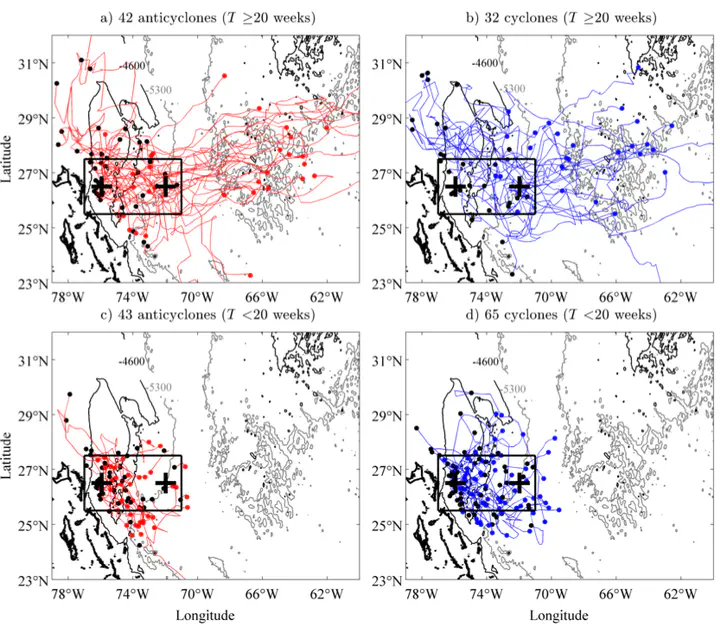The effect of eddies and Rossby waves on the Atlantic meridional overturning circulation at 26.5◦N and their decay at the western boundary.
 Eddy paths of anticyclones (red, a and c) and cyclones (blue, b and d) which travelled within the area identified by the black rectangle (from 25.5 to 27.5◦N and from 71 to 77◦W) between May 1992 and December 2012. Eddies with a lifetime longer (shorter) than 20 weeks are displayed in top (bottom) panels. The last and first eddy locations are marked (black and red/blue points, respectively). The 4600 m contour (thin black line) indicates the Blake-Bahama outer ridge located between the mooring Wb4 and Wb5, both marked by the black crosses.
Eddy paths of anticyclones (red, a and c) and cyclones (blue, b and d) which travelled within the area identified by the black rectangle (from 25.5 to 27.5◦N and from 71 to 77◦W) between May 1992 and December 2012. Eddies with a lifetime longer (shorter) than 20 weeks are displayed in top (bottom) panels. The last and first eddy locations are marked (black and red/blue points, respectively). The 4600 m contour (thin black line) indicates the Blake-Bahama outer ridge located between the mooring Wb4 and Wb5, both marked by the black crosses.Abstract
The meridional overturning circulation (MOC) at 26.5◦N in the Atlantic has a standard devia- tion of 4.9 Sv and contains large fluctuations at subannual periods. The geostrophic component of the MOC is believed to be influenced on subannual timescales by eddies and Rossby waves. To quantify this effect, the vertical structure and surface characteristics of westward propagating signals are studied using altimetry data and full-depth mooring measurements from the RAPID array at 26.5◦N. Westward propagating features are observed in the western North Atlantic in both datasets and have periods of 80–250 days in the first baroclinic mode. These features are still observed by the RAPID moorings 20 km offshore of the western boundary. The effect of eddies and Rossby waves on the geostrophic transport is quantified by representing their vertical structure with the first baroclinic mode. In total, 42% of the variance of the transbasin thermo- cline transport inferred from geostrophic calculations at 26.5◦N can be attributed to first mode variability, which is associated with eddies and Rossby waves at periods of 80–250 days. The standard deviation of the transbasin thermocline transport due to eddies and Rossby waves is estimated to be 2.6 Sv. Having observed eddies to propagate towards the western boundary; the aim of the second section is to study the eddy energy sink at the boundary as one component of the energy redistribution from large scale winds to smaller scale internal waves. This section investigates the generation of internal waves by eddies in the North Atlantic western boundary where eddies dissipate. The eddy presence and decay are measured from the altimetric surface relative vorticity associated with an array of full-depth current meters extending ∼100 km offshore at 26.5◦N. In addition, internal waves are analysed over a topographic rise from 2-year high-frequency measurements of an Acoustic Doppler Current Profiler (ADCP), which is located 13 km offshore in 600 m deep water. Despite a polarity independence of the eddy decay observed from altimetric data, the bottommost 100 m flow is enhanced for anticyclones (25.2 cm s−1) compared with cyclones (-4.7 cm s−1). Accordingly, the internal wave field is sensitive to this polarity-dependent deep ve- locity. This is apparent from the eddy-modulated enhanced shear spectra and dissipation rates, which are obtained from a finescale parameterisation, ε=2.8×10−9 W kg−1 for |v|>8 cm s−1, whilst ε=0.9×10−9 W kg−1 for |v|<8 cm s−1. The local dissipation of anticyclones signifi- cantly contributes to the eddy decay at the western boundaries. The present study underlines the importance of oceanic western boundaries for removing the energy of low-mode westward propagating eddies to higher mode internal waves.